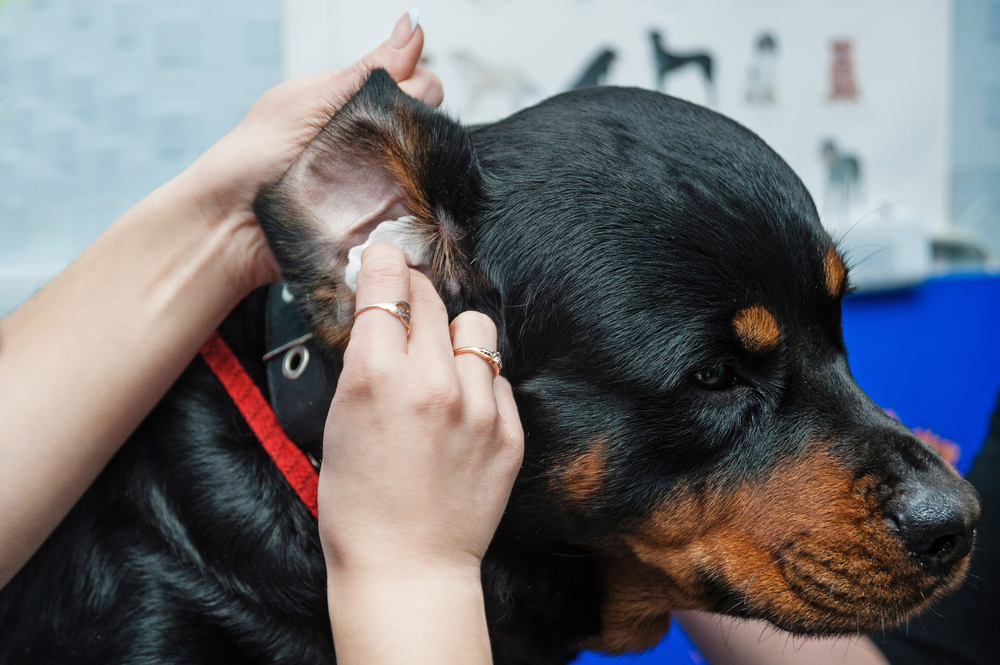Ear infections frequently cause problems for dogs, and can be painful for your pet, significantly impacting their quality of life. Many dogs suffer from chronic or recurring ear infections, which can be frustrating to manage. Our team at Willow Wood Animal Hospital wants to provide information on this topic by answering some frequently asked questions about chronic ear infections in dogs.
Question: Why are ear infections common in dogs?
Answer: Ear infections account for about 15% of canine veterinary visits. Two factors contribute to this frequency:
- Ear conformation — The dog’s ear canal has vertical and horizontal components that create a “L” shape, which means that material inside the ear canal must travel upward—unlike the human ear canal, which has only a horizontal component that allows material to travel straight out. Debris that can’t get out accumulates inside the ear. When wax, skin oil, and moisture build up, the normal bacteria and fungi living in the ear canal feed on this material and proliferate, causing infection.
- Predisposing conditions — Several conditions facilitate dog ear wax and moisture to accumulate. Certain breeds, such as the Shar pei, have narrowed ear canals that hamper ear drainage. Other breeds, such as the Bassett hound, have long, pendulous ears that trap moisture inside. Also, allergic skin conditions, irritation from water accumulation, ear mites, foreign bodies, and hair growth inside the ear canal can predispose dogs to ear infections.
Q: What are ear infection signs in dogs?
A: Ear infections can affect the outer, middle, or inner ear, with varying signs, depending on the structures involved. Signs include:
- Otitis externa — Otitis externa is the most common disorder affecting the dog’s ear canal, and occurs when the cells lining the external ear canal become infected and inflamed. Signs include headshaking, odor, redness, swelling, scratching, discharge, and scaly skin.
- Otitis media — Infection and inflammation affecting the middle ear structures can occur if otitis externa progresses, or a foreign body penetrates the eardrum. Signs include head shaking, rubbing or scratching the affected ear, rotating the head toward the affected side, redness, discharge, and odor. Because nerves innervating the face and eye travel through the middle ear, other signs may include facial nerve paralysis, pupil constriction, eyelid drooping, and third eyelid protrusion on the same side as the affected ear.
- Otitis interna — Otitis media may progress to otitis interna, and involve the inner ear structures. Signs include difficulty walking, an involuntary side-to-side rhythmic eye movement (i.e., nystagmus), and hearing loss.
Q: What complications can occur in dogs affected by ear infections?
A: In addition to neurological complications, otitis media and interna cause other complications, including:
- Proliferation inside the ear canal — Persistent infection can cause tissue proliferation and scarring inside the ear canal, making resolution difficult.
- Aural hematoma — Dogs affected by ear infections frequently scratch the ear and shake their head, which can rupture a blood vessel in the earflap, and cause an aural hematoma. These lesions typically require drainage, cleaning, and bandaging to prevent recurrence and scarring.
Q: How are ear infections diagnosed in dogs?
A: Dogs affected by ear infections typically are painful, and exhibit obvious signs, but determining the best therapeutic approach requires diagnostics, including:
- History — A thorough history, including if your dog has had previous ear infections, if they have any allergies, and what food they eat, will be needed.
- Otoscopy — Your dog’s ear will be examined using an otoscope. Sedation may be required if the ear is too painful.
- Cytology and culture — An ear swab sample will be taken to determine what pathogen is causing the infection.
- Blood tests — A complete blood count and biochemistry profile may be recommended to evaluate the dog’s overall wellbeing.
- Skull X-rays — Skull X-rays may be necessary to determine how far the infection has advanced.
- Allergy testing — Your dog may need allergy testing if environmental allergies could be contributing to their condition.
- Food elimination trial — A food elimination trial may be needed if a food allergy could be contributing to your dog’s condition.
Q: How are ear infections treated in dogs?
A: Ear infection management depends on infection severity and chronicity. Treatment options include:
- Simple ear infections — Most ear infections can be treated with a professional veterinary cleaning, followed by at-home medical treatment. An ear swab sample can help determine the appropriate antibiotic for your dog. Their ears will be rechecked after one to two weeks to ensure the infection has resolved.
- Chronic and recurring ear infections — If the infection is not resolved after a thorough cleaning and medical treatment, further testing may be required. Pets who have chronic or recurring ear infections are commonly diagnosed with allergies, and allergy testing may be recommended. Routine disinfecting ear washes may also be recommended.
- The end stage ear — In severe cases, when the ear canal shows proliferation and scarring, surgery may be required. Procedures include a lateral ear resection to remove the ear canal’s vertical portion, and a total ear canal ablation (TECA) to remove and seal the ear canal.
Q: How are ear infections prevented in dogs?

A: Steps you can take to decrease your dog’s risk for ear infections include:
- Drying your dog’s ears — After bathing and swimming, dry your dog’s ears thoroughly.
- Cleaning your dog’s ears — Clean your dog’s ears regularly using an appropriate ear cleaner. Do not use hydrogen peroxide or alcohol, which can irritate your dog’s ear.
- Monitoring your dog’s ears — Monitor your dog’s ears closely to detect early stage ear infections, which are easier to treat and manage.
Preventing ear infections or treating them in the early stages is the best way to ensure they don’t become a chronic problem. If your pet has a painful ear, contact our team at Willow Wood Animal Hospital, so we can relieve their distress.







Leave A Comment